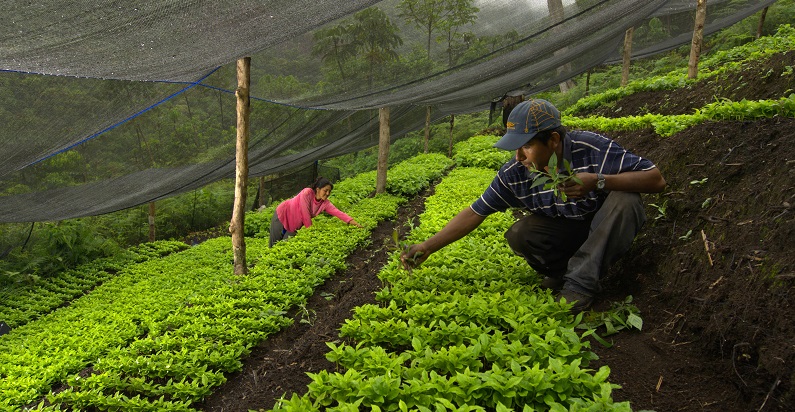-
The planting of cocoa or coffee has become an alternative for people who subsist by cultivating and harvesting narcotic-containing plants. "Alternative development", an option for changing the way of life of hundreds of families. This system has already helped 190,000 families in Colombia. The planting of cocoa or coffee has become an alternative for people who subsist by cultivating and harvesting narcotic-containing plants. "Alternative development", an option for changing the way of life of hundreds of families. This system has already helped 190,000 families in Colombia." />
26 February 2015
Category : Opinion
Anti-drug crops
El cultivo del cacao o el café se ha convertido en la alternativa de aquellas personas que subsisten de la plantación y recolección de plantas que contienen estupefacientes. El ‘Desarrollo alternativo’, una opción para cambiar la forma de vida de cientos de familias. Este sistema ya ha atendido a 190.000 en Colombia. The planting of cocoa or coffee has become an alternative for people who subsist by cultivating and harvesting narcotic-containing plants. "Alternative development", an option for changing the way of life of hundreds of families. This system has already helped 190,000 families in Colombia. The planting of cocoa or coffee has become an alternative for people who subsist by cultivating and harvesting narcotic-containing plants. "Alternative development", an option for changing the way of life of hundreds of families. This system has already helped 190,000 families in Colombia. The planting of cocoa or coffee has become an alternative for people who subsist by cultivating and harvesting narcotic-containing plants. "Alternative development", an option for changing the way of life of hundreds of families. This system has already helped 190,000 families in Colombia.

Rural farmers, African-descended, Raizaland indigenous groups. Families belonging to these four communities in Colombia have resorted to illegal cultivation of plants like coca and poppies (from which heroin is derived) as a way of life. The ease of cultivation offered by the zones where they live or coercion by criminal networks are the main reasons why they get involved in this practice. Since 2003, this South American Country has been working on Alternative Development (AD) for the main purpose of obtaining territories free of illegal crops. According to the United Nations Office on Drugs and Crime (UNODC), AD is a process designed to reduce and eradicate cultivation of plants containing narcotic as well as psychotropic substances by offering alternatives such as cocoa, coffee, bananas, edible palms, etc.
“Invigorating the economy of the region and strengthening the culture of legality of these families and organizations”, adds Patricia Meléndez, director of the Programme to Combat Illegal Crops in Colombia. Since its beginnings, AD has helped 190,000 families in Colombia, and in the last two years it has managed to reduce the number of hectares dedicated to coca cultivation from 64,000 to 48,000.
Preventive perspective
This is the goal, and achieving it requires preliminary awareness-raising and basic prevention work. “It’s not just a question of supplanting crops that can be diverted for illegal purposes of drug production but of preventing vulnerable areas from becoming dedicated to the production of these drugs”, explains Claudia Liebers, expert in the Cooperation Programme Between Latin America and the European Union on Drug Policies (COPOLAD). This FIIAPP-managed European programme assisted Colombia in holding onto this perspective from 2011 to last January, when it reached its close.
It did so by creating an exchange network in which AD is referred to other Andean countries like Peru, Ecuador and Bolivia. Mexico and Guatemala also showed interest shortly before the close of COPOLAD. This exchange has led to an exchange of best practices between neighbouring countries to halt the spread of illegal crops. The challenge was to combine the different drug policies, since in the case of Bolivia coca cultivation is legal. “That’s where the richness lies: in seeing these differences, but at the same time analyzing the great similarities between these countries and how working together contributes to making progress more effectively”, indicates Liebers.
Forums, workshops, women
The exchange tools between these countries provided by COPOLAD included the holding of regional forums, workshops and working groups, and development of a study and a manual on livelihoods and needs in the cultivation zones. Without forgetting the gender perspective. The programme put together a photographic exhibition and two videos which highlight the role of women in these zones as an engine of change. This is the case of Colombia. “We have some rural zones where the women are the ones leading the Alternative Development process in the territory. They’ve been given a role and they are the ones who become ambassadors in the territory to spread the lessons learnt in everything having to do with the COPOLAD programme”, indicates Patricia Meléndez.
One of the strong points of COPOLAD, which for the past four years has connected 17 Latin American countries with Europe to strengthen their public policies on drugs, has been to promote AD with the clear intention of involving local stakeholders in its development, as well as in the formulation of drug policies. The dialogue between institutions and local stakeholders was an essential part. “The goal is to go beyond Alternative Development”, emphasizes Liebers in conclusion: “achieving comprehensive development in these zones that generates greater social inclusion for these people by providing a dignified standard of living and respect for human rights, so that they do not have the need to cultivate crops or carry out tasks that might be linked to the production of illegal drugs”.
The views and opinions expressed in this blog are the sole responsibility of the person who write them.






